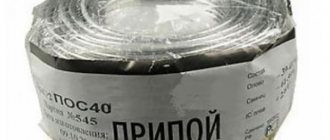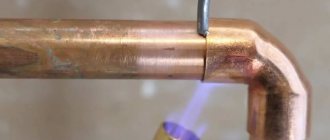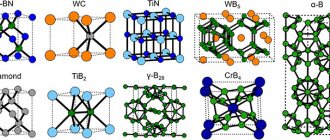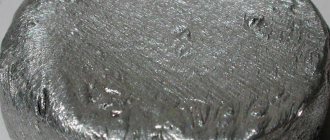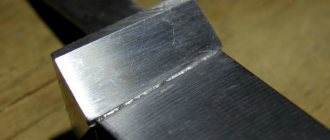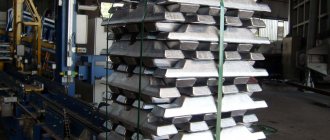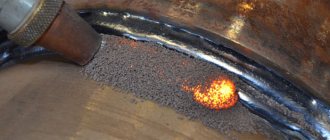When performing metal soldering, there is always a need to use solder, the quality of which directly affects the durability of the completed connection of metal parts. It should be said that solder is a consumable material and is made from various alloys. Manufacturers are constantly improving this material, which ensures high-quality connections and simplifies soldering. Rosin solder is an inexpensive and at the same time high-quality material that is versatile and can be used for soldering various metals.
This solder contains rosin, which eliminates the need to purchase and use additional materials. Rosin simplifies the melting of the surfacing material, which in turn improves the quality of the joint. Another constant advantage of such solder is its low melting point, and this in turn allows you to avoid changing the structure of the base metal being connected.
The flux in the solder is in the form of rosin, so there is no need to use it additionally. This greatly simplifies the soldering procedure, which professionals and ordinary homeowners will appreciate. Note that the percentage of rosin is in the optimal amount, while using it separately, there is a danger of taking more and less material. All this has a positive effect on the quality of welding work performed.
Flux
Solder with rosin in the form of a hollow wire twisted into rings is common on sale . A flux of similar composition is made from coniferous trees; such a substance becomes soft when heated to 50 ° C, and at 250 ° C it begins to boil with partial evaporation. Rosin must be removed after finishing work, otherwise oxidation will occur, and the substance, absorbing moisture from the air, will begin to interfere with the proper operation of the devices.
Popular formulations
There are three main categories:
How to properly solder with a soldering iron using rosin
instrument.guru > Welding > How to properly solder with a soldering iron using rosin
Almost every man, be it an ardent fan of delving into radio equipment and electrical appliances or a simple owner who is faced with a situation in which the process of joining metals and wires is required, sooner or later will be forced to use a soldering iron, in this case you can to cope with the task yourself .
- Devices and tools required for the soldering process
- Recommendations for competent work with a soldering iron using rosin
- Correctly soldering with a soldering iron with rosin: general recommendations
Devices and tools required for the soldering process
In everyday life, when it is necessary to repair something basic, special experience and expensive units and tools for soldering are not required. The main ones are the following devices and tools:
- Soldering iron. The main criteria when choosing it are the size, which must correspond to what you are going to solder, otherwise there is a risk of damage to adjacent circuit elements or poor-quality soldering of wires and power (it is advisable to purchase a pair of soldering irons, one for 25 watts for soldering microcircuits, the second for 40-watts). 60 watts in order to solder wider parts of parts).
- Soldering iron stand. When working with a soldering iron for a long time, you have to frequently unplug it to avoid overheating, then wait until it warms up again. Due to the fact that the soldering device heats up to 300 degrees, you simply cannot do without a stand for it.
- Rosin and solder. Rosin is an amorphous substance obtained from the resin of coniferous trees, very fragile under mechanical shock. What is rosin needed for? When soldering, it is used to degrease the surface and remove oxide films. Solder is an alloy of two metals - lead and tin for soldering.
Preparing tools and materials for soldering
Soldering is the process of joining parts by introducing molten metal of a lower temperature into the area of their contact. Before you start soldering, you need to carefully prepare for work:
- Preparing the soldering iron for subsequent use.
The main task of all manipulations is to cover the working area of the soldering iron tip with a thin layer of solder. Method 1: when the soldering iron is first heated, its tip must be cleaned, thereby protecting it from oxidation and wear. Having warmed it up to operating temperature, you can touch the sting to the rosin, melting the solder on it, and then rub it on a wooden surface. Method 2: wipe the heated tip of the soldering iron with material treated with soldering acid, melt the solder and distribute it over the tip with a piece of solid ammonia using the rubbing method. - Preparing parts for soldering.
- Regardless of the type of soldering (low-temperature or high-temperature), the surfaces of the parts must be thoroughly cleaned of oily and greasy contaminants and degreased using rosin or solvents. If there is rust, it must also be removed by any mechanical means. If you need to solder the wires, it is better to twist them together first, since tin is a rather soft metal that may not withstand even the slightest load.
Recommendations for competent work with a soldering iron using rosin
Rosin easily dissolves in organic compounds such as alcohol, acetone and others. When heated to 150 degrees, it is capable of breaking down chemical elements such as tin, lead, and copper.
Rosin is used in radio and electrical repair work as an antioxidant component for soldering. Its proper use will significantly reduce the spreading and surface tension of the solder, destroy the oxide film and prevent the formation of a new one.
Before you start soldering the necessary elements, you need to clean and then tin the contacts. To do this, place a piece of solid rosin on the part of the surface that will be soldered and press it with a soldering iron heated to the required temperature.
Low temperature options
In first place is the WOOD alloy with the composition: 10% Sn and Cd each, 40% Pb and Bi, the beginning of the melt is 65-72 C. The second position is occupied by a solder called ROSE, which begins to melt at 90-94 C. Consists of: 25% each of tin and lead, and the remaining 50% is bismuth. The above alloys are expensive solders.
The third place among low-temperature products is occupied by POSK-50-18, with a temperature of 142-145 C. The composition of this solder includes 50% tin, 32% lead and 18% cadmium, which increases corrosion resistance, but adds toxicity to it.
The second nominee (called ROSE) is very popular among radio amateurs, but in domestic radio electronics its marking is POSV-50, where the numbers are the percentage of bismuth. Used for installation/dismantling and tinning of overheat-sensitive copper tracks on printed circuit boards.
Soldering through-hole components
1. Install the component into the mounting holes, if necessary, bend the leads.
2. Apply the soldering iron tip in such a way that simultaneous contact is ensured with the mounting hole CP and the component lead, warm up for 0.5-1.0 s.
Read also: Name of Spanish dance with castanets
Struck No. 1. It is necessary to ensure good thermal contact between the soldering iron tip and the soldered surfaces.
3. Apply a small amount of solder to the soldering iron tip so that a solder bridge is formed between the CP and the terminal (see figure).
4. Move the tubular solder in a circle along the CP in the opposite direction from the soldering iron tip (see figure).
5. Once the solder joint is formed, remove the solder rod.
6. At the same time, remove the soldering iron tip. To form the correct fillet shape, the soldering iron tip must move upward along the component lead.
Rule No. 2. It is necessary to ensure contact between the soldering iron tip and the soldered surfaces until a solder fillet is formed.
Attention! Avoid applying strong pressure with the soldering iron tip to the gearbox. Do not allow the soldering iron tip to contact the solder fillet without using tubular solder, this may cause degradation of the solder joint.
What solders are used for soldering radio components?
The main types of solders used are PIC (tin-lead solder) and lead-free solders. POS has a melting point of approximately 180 to 230 °C. This alloy is well suited for soldering parts, but on an industrial scale, lead-free solders are used, which have a slightly higher melting point from 180 to 250 °C. Lead-free solders do not contain lead, they emit fewer emissions and, most importantly, they do not contain lead. Lead vapor is highly polluting to the environment, so lead-free solders are used during the production of printed circuit boards. However, lead-free solders not only melt at higher temperatures (due to the absence of lead), but they also leave a “tin whisker.” These whiskers can cause a short circuit after soldering SMD contacts. They are hardly distinguishable without a microscope, and their thickness is less than 1 micron.
Lead-free solders are also used in BGA soldering as solder balls.
POS solders are suitable for radio amateurs. These are easier to solder, and they won’t cause much harm if you don’t solder on an industrial scale. Moreover, lead-free solders do not reach the level of PIC solders in terms of wettability and quality of contact after soldering.
Classification by type
Solders are produced:
- With flux;
- No flux.
It is convenient to use solders with flux on a soldering iron, since the flux helps to be distributed over the soldering iron tip. Also, solders with flux are very soft, and they can be rolled into several rods.
According to condition
Solders are produced mainly in the form of rods with a cross-section from 0.1 to 2 mm. This is the hard type. There are also solder pastes. It is a mixture of microscopic beads in flux. Used for BGA soldering.
Solder paste is mainly used for soldering microcircuits and connector pads. It is irrational to use paste for soldering wires, since the price of paste is much higher than regular solder.
Low temperature alloys
In addition to soft solders, there is also a subtype of them. These are low-temperature alloys of Rose and Wood.
Such alloys are usually used for safe soldering of parts. These alloys are not recommended for soldering parts onto a board due to their low mechanical strength and melting point (from 60 to 100 °C)
Chemicals for soldering
Soldering is the joining of parts together; two main components are used to connect these parts: solder and flux. Not a single soldering process is complete without materials such as solder, flux, rosin; some radio amateurs use soldering acids, various mixtures, etc. In this article we will talk about them.
Solder (tin)
Solder is a metal or alloy used for joining and soldering radio components; it has a melting point lower than the metals being joined. Solder firmly connects radio components to each other, spreads over it and fills gaps or holes between the parts being connected.
Solders can be soft – melting point up to 300°C and hard – above 300°C. Soft solders are tin-lead alloys.
They are sold in coils, tubes or in the form of rods. Solders are even sold with flux; these melt easier and rosin is usually not required for soldering radio components. Radio amateurs often use POS-61 brand solder.
When using low-temperature solders, a special flux is required, since standard flux is inactive at low temperatures.
Lead-free solders have a melting point either higher or lower than lead-tin solders. Tin-lead solders are wetted better than lead-free solders and are more convenient to solder with. Seams when using lead-free solders that occur during long-term use are also worse than those with lead-containing solders.
Rosin
Rosin can be spruce or pine; it is used for soldering radio components together with solder; rosin speeds up soldering and promotes rapid tinning of radio components. Rosin helps the solder stick to the surface and spreads over it in a shiny film. After this, the part is soldered very easily.
Before starting soldering, the heated soldering iron is first “dipped” into rosin, then the tip of the soldering iron is touched to the solder, after which it is touched to the place where the parts are soldered. The amount of rosin here plays an important role and there is no need to skimp on it. There are other ways to apply rosin, for example, by bringing a piece to the soldering point, for example, tinning the output of radio elements or tinning wires, it all depends on the specific case.
Flux
Flux is designed to remove oxides or fatty contaminants from the metal surface, improve the spreading of liquid solder and to wet the soldering area. Using flux, the leads of radio components are tinned and soldered very quickly. Fluxes are either chemically active (acidic) or passive (neutral). Active fluxes are those fluxes that contain substances that can interact with metal, such as acids and zinc chloride. When using such fluxes, solder seams are subject to corrosion, which, of course, is a disadvantage of these types of fluxes. But this does not mean that such fluxes cannot be used; it is possible, only after finishing the work, the board must be cleaned of this flux. One of these fluxes is flux LTI-120.
Many radio amateurs use neutral flux SKF, this flux consists of: alcohol ~ 60%, rosin ~ 40% and is absolutely not harmful to printed circuit boards.
You can make such a flux yourself at home; for this you take alcohol (70-90%), you can buy it, for example, at a pharmacy, and rosin, which needs to be crushed. Then we pour the alcohol into a small container, for example, into a tube, and pour rosin crumbs there, in a percentage ratio of approximately 70% alcohol and 30% rosin, then close the cap and shake until the rosin is completely dissolved.
Fluxes are available for soldering aluminum, stainless steel, brass, copper and steel products, in the form of a solution or powder. Under normal conditions, aluminum is difficult to solder, since an oxide film immediately forms on its surface after cleaning. Therefore, after cleaning, the site of the future weld on aluminum or its alloys is immediately filled with pre-molten rosin. Soldering is carried out with a powerful (at least 100 W) soldering iron, using solder consisting of 80% tin and 20% zinc or 95% tin and 5% bismuth. Solder is picked up on a soldering iron and transferred to the rosin-protected junction surface. Aluminum tinned in this way is relatively easy to solder. You can solder, for example, copper wires to its tinned surface.
Solder paste
Solder paste is a paste-like substance consisting of tiny balls of solder, flux and various additives. Solder pastes are either no-clean or water-washable; the latter contain active substances, particles of which can cause corrosion if not removed from the surface of the printed circuit board.
Solder paste is mainly used for surface mounting, for chip (SMD) radio components and is especially convenient for soldering in hard-to-reach places. Soldering of radio components with such paste is carried out using a soldering (hair dryer) or IR station. In short, the technology is as follows: first, drops of paste are applied to the future junction sites, radio components are placed and heated.
The sequence of actions for soldering is as follows:
1. First, the surface of the board must be cleaned, degreased and dried. To speed up drying, you can use a hairdryer.
2. The printed circuit board must be securely fixed in a horizontal position to prevent components from falling off.
3. Solder paste must be applied to the printed circuit board in places of future soldering, ensuring that the entire soldered surface is wetted with the paste.
4. Parts are installed on the board: chip resistors, capacitors, microcircuits, etc... Try to achieve precise alignment of the pins of the microcircuits and the components on the printed circuit board.
5. Ideally, the board should also be heated from below; after a couple of minutes, the hair dryer is set to a temperature of 150*C and with a gentle stream of air so as not to blow away the parts, the soldered upper side of the board is heated along with the installed parts. Heating continues until the flux from the solder paste evaporates. Next, the hair dryer is set to a temperature of about 240*C (the melting point of tin-lead solder paste is about 200*C), and the surface of the board is heated again, and the solder particles in the paste should melt and form a neat solder joint.
6. After finishing soldering, the board needs time to cool, then you can wash it
Soldering fat and soldering acid
Soldering fat (can be active or neutral) is needed for the same purposes as rosin, removing the invisible oxide shell from the metal and improving soldering. But if rosin does not cope with this task and cannot remove this shell from the steel, then solder fat - please!
If the metal does not want to be tinned, soldering acid is used. The advantages of acid are that it degreases parts for soldering faster and better than rosin and solder fat.
Its disadvantage is that after soldering it reacts with the metal for a long time, and is also a very good conductor of electric current, so self-respecting electricians and electronics engineers never use it, they have no use for extraneous current paths.
Copper, bronze, brass can be soldered with rosin or flux, lead will not be soldered with rosin, you need to solder with soldering oil. If nickel, steel or iron are used, soldering acid is used; after soldering, the remaining acid must be washed off with water. If there is a choice, then you should still choose solder fat, because... it combines the advantages of both acid and liquid rosin (flux).
Borax
This is a high-temperature flux (700-900*C), borax is used as a flux for soldering steel, cast iron, copper and its alloys with medium-melting copper, brass, gold and silver solders. Molten borax dissolves metal oxides and cleans the surface of the parts being soldered. After using borax during soldering, it is necessary to remove the remaining salts using mechanical stripping.
Borax and boric acid, when mixed one to one by weight, form boric flux. You need to mix the ingredients, grind thoroughly in a porcelain mortar, dissolve in distilled water while heating and evaporate to a solid residue. To increase the activity of the flux, fluoride and chloride salts are added to the mixture.
Oxidal
Used for cleaning soldering iron tips or for soldering oxidized leads of radio components. For best oxide action, the soldering iron should be at least 40 watts. Oxidal is sold in powder form; when working with it, it emits an unpleasant odor and the area near the soldering becomes covered with “frost.” After soldering with oxide, the residues are removed mechanically.
Tsaponlak
Tsaponlak is used to cover printing tracks to protect them from external influences, for example, to protect them from moisture. Over time, microcracks may appear at the places where radio components are soldered, and the penetration of water vapor into the crack over time causes the formation of non-conducting oxides. Tsaponlak applied to the soldering point forms a strong surface elastic film and protects this place from moisture.
Tsaponlak comes in different colors: green, red, blue... It is better to apply it to the board with a brush or soft sponge. I do not recommend covering entire printed circuit boards with tsaponvarnish (or in general with any acetone-containing substances). Special colorless varnishes are sold for these purposes.
Board coated with tsapon varnish:
Tsaponlak is convenient to use for fixing threaded connections, for example, so that a nut does not come loose.
Types and brands of solders, their composition, purpose and application
There are many types of solder with different compositions, characteristics and purposes. In accordance with the main classification, they are divided into refractory or hard, and fusible or soft. Their main difference is the melting point, which determines the difference in areas of application.
Refractory solders
Refractory solders, which melt at 450–500°C, produce a very hard joint. They are alloys based on copper, zinc, silver, brass, gold, aluminum, magnesium and nickel. Brazing alloys are used when soldering materials with a high melting point.
Basic properties of solders
When choosing a specific brand of solder for soldering copper wires or aluminum alloys, you must be guided by their technical characteristics.
However, for all compositions a list of basic properties can be identified:
- wettability - shows how well the solder envelops and sticks to the parts being soldered;
- strength - determines the ability to withstand mechanical forces and loads; for this, boron, iron, nickel, zinc or cobalt can be added to the composition;
- plasticity - the ability to deform, achieved through additives from manganese, bismuth, lithium, etc.;
- resistance to high temperatures - important for soldering with hard alloys that are found in boiler rooms, furnaces, pipelines, heating devices, the property is achieved by adding tungsten, zirconium, vanadium, hafnium, niobium, etc.
- resistance to corrosion destruction - increases by alloying with copper or nickel.
Solder with rosin
When assembling or repairing electronic boards and various electrical devices, radio components are fixed by soldering. Workers attach them to the required areas with a soldering iron, where solder serves as consumables.
At the same time, the processed parts remain solid and are not subject to melting. An alloy is melted, which wets and attaches electronic components. For good adhesion, surfaces must be cleaned with fluxes . To simplify the work process and improve the quality of connections, universal rosin solders were created. The developers saved the craftsmen from collecting additional substances and performing unnecessary operations by including the optimal amount of resin in the product.
They are produced in the form of hollow wires, the space of which is filled with components:
- Rosin.
- Synthetic.
- Water-washable.
Soldering with tubular material does not require additional fluxing, which increases productivity. During production, solders differ:
- Rosin content.
- Wire thickness
Finished products go on sale with different configurations in the form of:
- Coils - where a wire up to 2mm thick is wound around a rod. Surfacing material is convenient to use in home and industrial workshops; you just need to select the parameters.
- Tubes - formed for work at home due to the small number in one set.
- Bays - which are more suitable for industrial enterprises. Wire of different sizes is packaged here; the buyer chooses the thickness and length according to his needs.
When choosing, the consumer relies on the convenience and quality of the work performed. For standard procedures with known execution modes, any brand from the POS category is suitable - 61 , 60 , 90 . The main component in these solders will be an alloy of silver or tin. Reduced joint strength increases the softness and wettability of the workpieces.
To join refractory metals, surfacing without internal fluxes is used.
Types of solders
All existing solders can be divided into three main groups:
- Refractory solders;
- Low-melting;
- Ultra-low-melting.
Refractory solders are not suitable for soldering radio components, since melting them requires a fairly high temperature, over 500 degrees. Refractory solders are capable of creating a very reliable connection of metals, which is characterized by a gap of at least 50/kg per 1 mm².
An electric soldering iron is not suitable for soldering with refractory solders, since it is not able to provide the required melting temperature. More powerful tools are already used here, for example, a gas burner.
Amateur radio solders, also known as light alloys, contain tin and lead. They are soft and melt well at temperatures up to 200 degrees. Therefore, most often it is light-alloy solders that are used for soldering radio components.
What is solder?
Solder is a pure metal or thermoplastic alloy made from several components. Designed to connect copper parts into a common integrated network.
When exposed to high temperatures, the solder melts, spreads across the processing area and seals the surface. After final cooling, a strong, even seam without errors is formed on the pipe material
The technology of joining two fragments, carried out according to this principle, is called soldering.
Among the main advantages of the technique it is worth highlighting:
- connection without deformation;
- preservation of the original shape of the processed parts;
- absence of any internal tension;
- excellent strength and high level of tightness of the created seam;
- resistance of the bonded area to different temperature conditions, including intense heating;
- simple separation of seam sections in case of need to change the system format.
Soldering is carried out with special equipment - a soldering iron, a gas torch or a blowtorch. Immediately before work, the area is thoroughly cleaned of surface defects and technical oils, and only then work begins.
The process of connecting pipe fragments is easy and quick, but requires mandatory compliance with basic safety rules. To avoid problems and injuries, you should wear thick work gloves on your hands, cover your face and eyes with special goggles or a mask, and protect your clothes with a thick apron. This will protect the technician from potential accidents.
For soldering at home, a soldering iron is most often used. A torch or lamp is used where the power capabilities of a soldering iron are not enough or where it is necessary to connect parts of great thickness and impressive mass.
How to use?
Flux and solder are two materials with different purposes. Solders are needed to fill the joint between two parts. And fluxes are needed to improve the quality of seams and protect them from oxidation. Therefore, the technology of application will be different.
To use solder, it must be preheated. If you are soldering small parts, apply solder to the soldering area and touch the wire with a soldering iron. The solder will melt and fill the joint. When welding, use a gas torch instead of a soldering iron.
As for solders with flux inside, everything is simple. Heat the flux and solder in the same way as when using regular metal solder. Using a soldering iron or torch. The solder will melt, releasing flux fumes.
To use fluxes, you need to know what consistency they are. Liquid fluxes are applied to the soldering site using a brush, paste fluxes are also applied (or with fingers), dry fluxes are applied to the welding site using a special apparatus.
How to choose the right solder
When choosing one or another type of such material, you should take into account the convenience of doing the work. In the event that standard work is performed, then you can use solder with any optimal brand of rosin. If you work with so-called PIC materials, it is best to choose solder, the components of which are silver. This will allow you to ensure high strength, softness and subsequent strength of the connection.
In each specific case, depending on the metal alloys used in the solder, its melting point can vary significantly. The choice in this case must be made solely depending on the characteristics of the main metal parts you are connecting. All this will ensure the durability of the soldering and the quality of such a connecting seam.
Also pay attention to the melting point of the solder and metal. The higher the temperature of the base metal, the higher the same indicator should be for the solder. In addition to the brand of such material, you also need to decide on the thickness of the wire. In this case, the choice must be made based on the thickness of the products themselves and the existing thickness of the weld. If you work with a soldering iron, then you can fuse a drop of flux of the required size from wire of any thickness. If you use gas welding, then you should use wire with a thickness of 0.8 to 1.5 millimeters. However, we note that the composition of the material is a much more important characteristic than its thickness.
